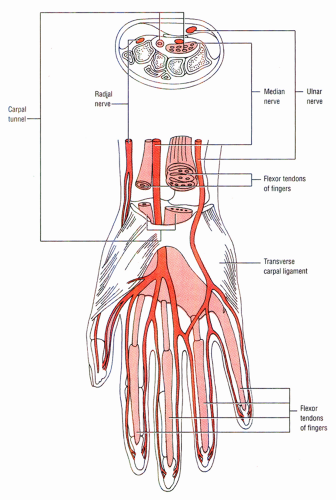Carpal Tunnel Syndrome
The most common nerve entrapment syndrome, carpal tunnel syndrome results from compression of the median nerve in the wrist where it passes through the carpal tunnel. (See Locating the carpal tunnel.)
The median nerve controls motions in the forearm, wrist, and hand, such as turning the wrist toward the body, flexing the index and middle fingers, and many thumb movements. It also supplies sensation to the index, middle, and ring fingers. Compression of this nerve causes loss of movement and sensation in the wrist, hand, and fingers.
Carpal tunnel syndrome, which usually occurs in females between ages 30 and 60 and is especially high in postmenopausal females, may pose a serious occupational health problem. It’s one of the three most common work-related injuries, largely because of the increased number of people using computers. However, the syndrome may also occur in people working in other occupations where continuous wrist movement is common—for example, butchers, computer operators, and concert pianists. Any strenuous use of the hands—sustained grasping, twisting, or flexing—aggravates the condition.
Causes
Because carpal tunnel syndrome is caused by compression of the median nerve, it’s often seen in patients with amyloidosis or in those with edema-producing conditions, such as diabetes, rheumatoid arthritis, pregnancy, premenstrual fluid retention, renal failure, or heart failure.
Repetitive wrist motions involving excessive flexion or extension also cause the carpal tunnel structures (tendons, for example) to swell and press the median nerve against the transverse carpal ligament. Dislocation or an acute sprain may damage the median nerve. Some experts think that a vitamin B6 deficiency contributes to carpal tunnel syndrome.
Locating the carpal tunnel
The carpal tunnel lies between the longitudinal tendons of the hand-flexing forearm muscles (not shown) and the transverse carpal ligament. Note the median nerve and flexor tendons passing through the tunnel on their way from the forearm to the hand.




